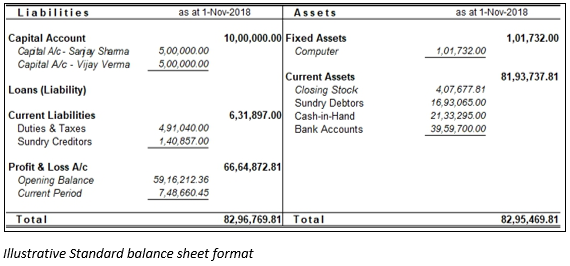Balance Sheet format
The format of the balance sheet consists of liabilities on one side and assets on the other sides. In some cases, the balance sheet is prepared in vertical format representing liabilities on top followed with assets. The visuals of balance sheet formats are given below for better understanding.


Components of Balance Sheet
As you can see in the balance sheet format, it consists of 2 broad components: Assets and Liabilities as discussed below:
Assets
Something that an entity has acquired or purchased and owned, regarded as having value and available to meet debts, commitments or legacies. Assets are further broadly classified as:
- Fixed Assets:
Assets which are purchased for long-term use and are not likely to be converted quickly into cash, such as land, buildings, and equipment. - Current Assets:
A current asset is an item on an entity's balance sheet that is either cash, a cash equivalent, or which can be converted into cash within one year. Examples of current assets are, Cash, Bank balances, Investments, Deposits, Accounts receivables and Inventory
Liabilities
Liabilities are the obligations or Debts payable by the enterprises in future in the form of money or goods. Liabilities are the outsider’s equity. Liabilities are further broadly classified as:
- Equity or Capital:
Money invested in the business to generate income. - Loans & Borrowings:
Money borrowed from a financial institution or from others to be utilized in business for generating income and managing the day to day affairs of the business. Loans are regarded as credit granted by the lender where the money is disbursed, and its recovery is made on a later date in a lump sum or in instalment. Ex: Bank Overdraft, Term Loan. - Current Liabilities:
Current liabilities are debts or obligations payable within a short period of time or one year. Ex: short term debt, trade payables, taxes due, accrued expenses.
Now that you have understood the basics of the balance sheet, it becomes easier for you to prepare a balance sheet and then reading through it. Preparation of balance sheet is not that difficult; it just requires you to report the closing balance of affected accounts. But gathering all the balances into a balance sheet is not that simple. Read our article ‘How to Prepare Balance Sheet and Read it?’ to know the complete process of preparing and analysing it.
Comments
Post a Comment